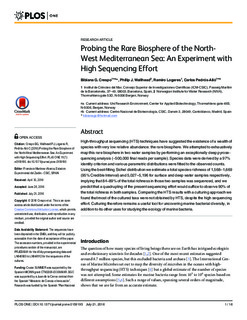Probing the Rare Biosphere of the North-West Mediterranean Sea: An Experiment with High Sequencing Effort
Journal article, Peer reviewed
Published version
Permanent lenke
http://hdl.handle.net/11250/2507293Utgivelsesdato
2016Metadata
Vis full innførselSamlinger
- Publikasjoner fra Cristin - NIVA [2149]
- Scientific publications [1172]
Sammendrag
High-throughput sequencing (HTS) techniques have suggested the existence of a wealth of species with very low relative abundance: the rare biosphere. We attempted to exhaustively map this rare biosphere in two water samples by performing an exceptionally deep pyrosequencing analysis (~500,000 final reads per sample). Species data were derived by a 97% identity criterion and various parametric distributions were fitted to the observed counts. Using the best-fitting Sichel distribution we estimate a total species richness of 1,568–1,669 (95% Credible Interval) and 5,027–5,196 for surface and deep water samples respectively, implying that 84–89% of the total richness in those two samples was sequenced, and we predict that a quadrupling of the present sequencing effort would suffice to observe 90% of the total richness in both samples. Comparing the HTS results with a culturing approach we found that most of the cultured taxa were not obtained by HTS, despite the high sequencing effort. Culturing therefore remains a useful tool for uncovering marine bacterial diversity, in addition to its other uses for studying the ecology of marine bacteria.

